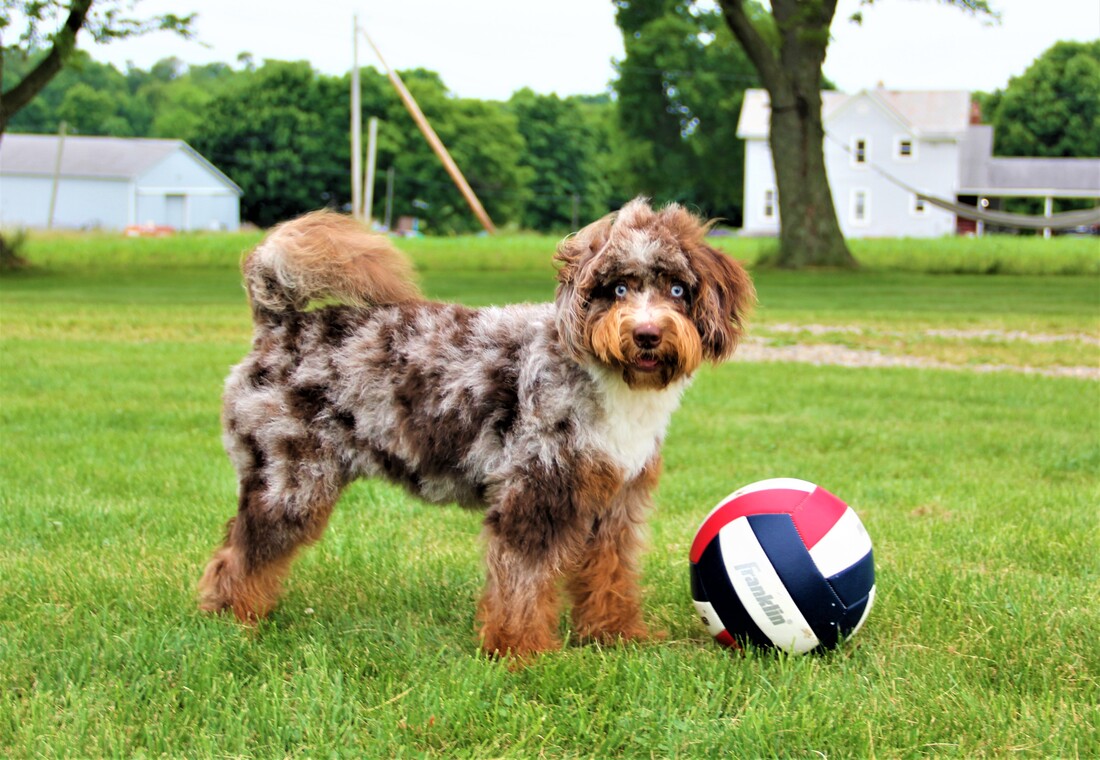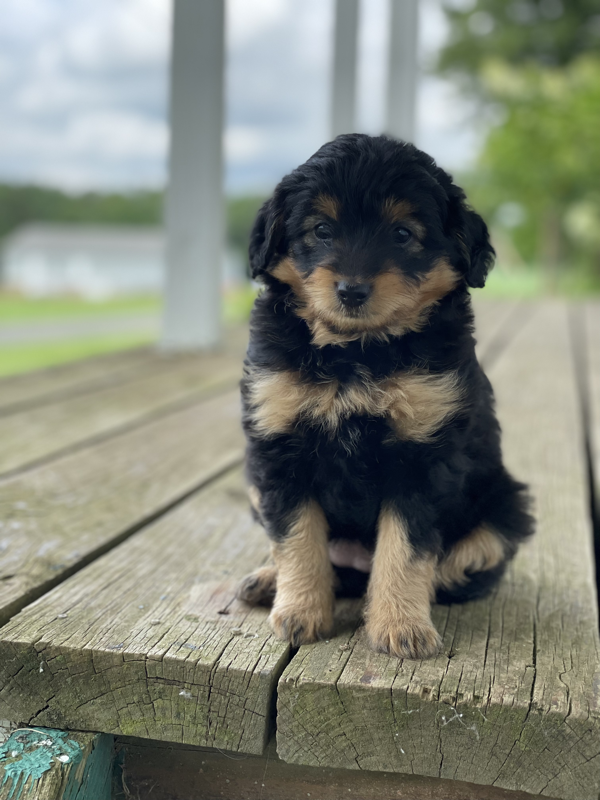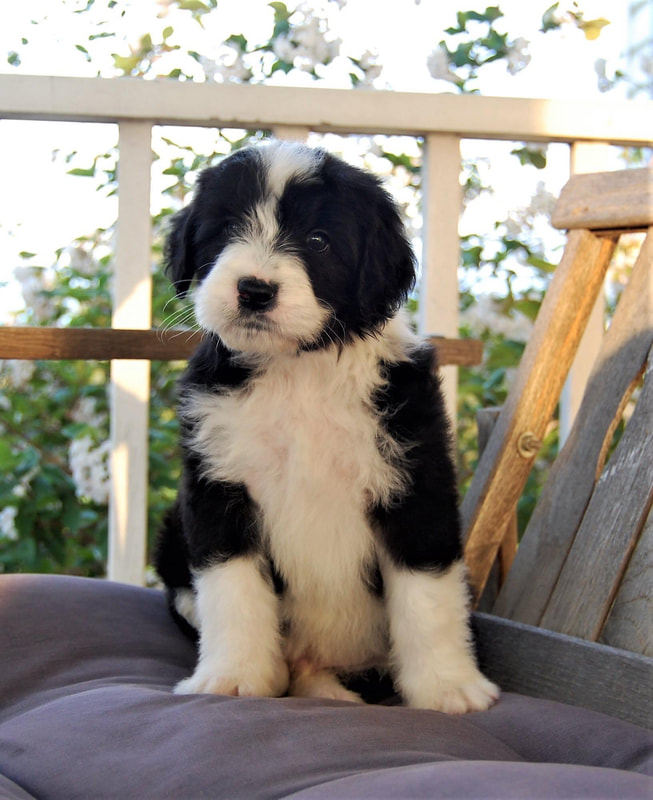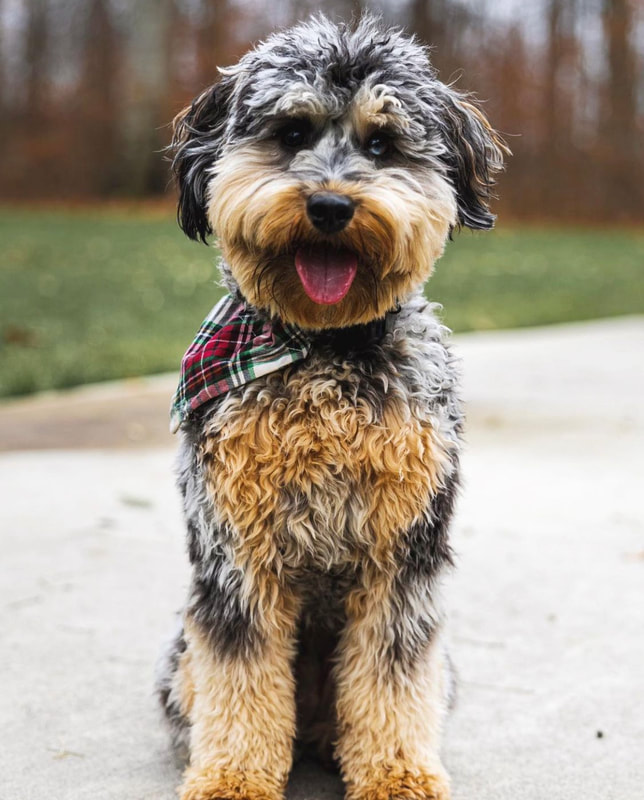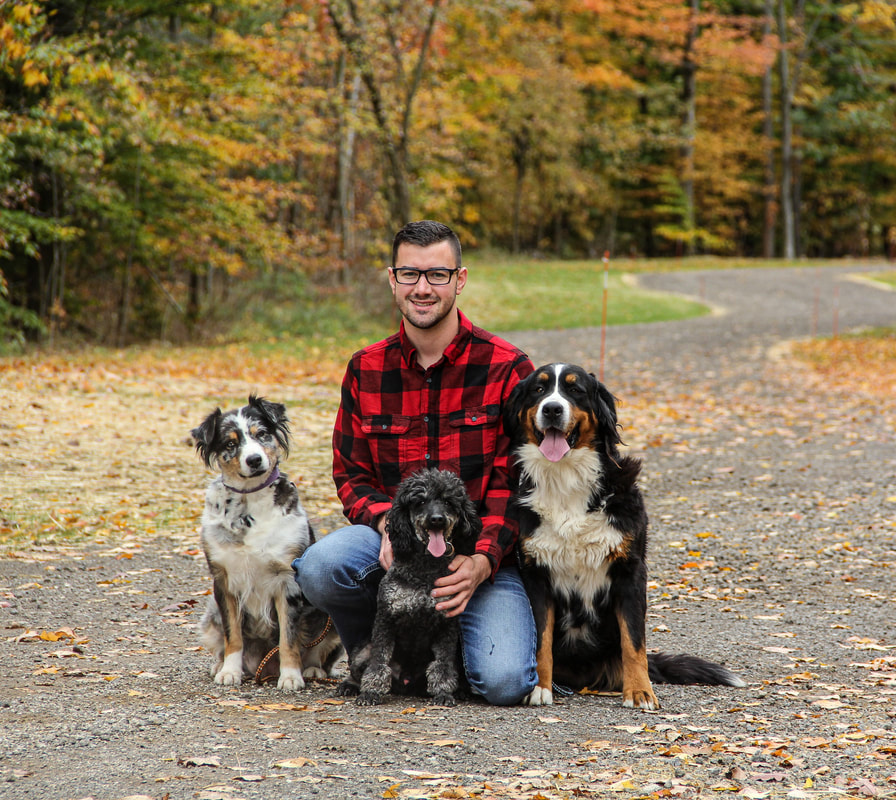|
Your looking for an Aussiedoodle (or any kind of doodle for that. matter) and you are getting confused by all the colors. What do all these colors even look like? I get it. It's complicated, and what makes it even more complicated is the fact that each breeder has their own reasons why they call a certain color the color they call it. Plenty of times, I see breeders listing puppies as colors they really aren't called. There are SO many color options in doodles and its definitely a learning curve and takes lots of dedication to learn the differences between each color. What complicates it more, is that lots of puppies look the same at birth, but as they get older - they change. With the Australian Shepherd already coming in a variety of colors itself, the Aussiedoodle is probably one of the only doodle breeds that comes in so many color options in its first generation. So... lets take a look at some of the most common colors that Aussiedoodles come in below! Blue MerleA true "Blue Merle", sometimes referred to as "Black Merle" (because of its black base color) has a mix of black, gray and sometimes white. The merle gene is a dilution gene, that dilutes the pigment on certain areas of the coat (causing the black to look a gray). A neat side note on the merles, merles have the highest chance of any color at having blue eyes, the reason for this is that if that dilution gene hits over the eye, it can dilute the eye pigment as well to the blue color (instead of brown, green, etc). Kind of neat, huh? What's even more intriguing is the fact that you can have a "marble colored eye" that is both blue and a different color (black, brown, green, etc) which gives the eye an almost "merle" color look as well when you look closely. Now - side note - there is also a blue eye gene in some breeds (for example: The Australian Shepherd) which can increase your chances at blue eyes but is not related at all to being Merle Colored. The puppy pictured below has a Blue Merle Base (the black and gray colors) with a small patch of white on his front chest (often times classified as "Abstract") as well as a small hint of brown (which is considered "Phantom" markings). I'll dig into a few more of these markings below. Brown Merle AKA Chocolate Merle (or "Red" Merle in Aussies)Brown Merle is the same as Blue Merle except the base color is brown. Most often, the best area to see the true color of a Merle Dog is to look at its body/back/rib cage area. This area does not usually show any of the markings such as Phantom or Abstract. This dog pictured here you can see the Dark Brown and the lighter Brown/Gray coloring spots that are diluted. You will also notice that her lower legs are a solid brown color (which is the phantom markings she has on top of the Brown Merle) This dogs true coloring is actually a Brown Merle Phantom Abstract. Lots of words - I know! But we will try to break each of these patterns and markings down as we move through the colors. Black PhantomThis puppy pictured below is a perfect example of a true Black Phantom. "Phantom" is the markings across the chest, on the lower legs, over (or around) the eyes, on the cheeks and also under the the base of the tail. On new born puppies, the phantom is not nearly as noticeable. But as the puppies age, the phantom markings generally come in more prominently. The easiest way to tell on a newborn puppy if they are phantom is to look under the base of the tail. Now, the phantom markings can vary GREATLY in color. The phantom coloring ranges from an almost white color to a very rich and deep red and anything in between (cream, apricot, etc). This is a gene that we are starting to learn more about known as "intensity". Now, something to keep in mind with the phantoms (and really any dog is fading and dilution). There is a test for dilute, which generally is visible at birth. If a dog is truly a dilute, they will be born with a lighter coat. The one that is much harder to guarantee is fading (as of now there is no test for this "gene" and it most likely is due to a variety of factors), but the fading gene is something that happens over time. As your dog gets older, the black will become more gray and the red coloring may lighten to cream or nearly white. A good gauge to base what your puppy may look like as an adult is to ask for pictures of the parents and see if they fade. If the parent dogs have held their color as they have aged, the chances of your puppy fading is much less (not a guarantee) than if one or both of the parents has faded. Brown PhantomBrown Phantom is the same as black phantom but it has a brown base instead of a black base. The phantom coloring can vary the same (being an almost white to a deep red). RedOne of my favorite colors, but one that definitely isn't super popular among Aussiedoodles is red. There are a number of concerns when breeding red dogs as the color red masks (or covers) all other patterns and markings. This is especially dangerous when you are breeding merle colored dogs. You see, merle is a dilution gene and it only takes one allele for the dog to show the pattern. If the dog has two alleles it is dangerous. You greatly increase your chances for blind and deaf puppies or puppies that are born with no eyes, deformed bodies, excessive white coloring, etc. due to the over dilution. This is why genetic testing is a basic MUST DO when breeding dogs. Reds can come in a variety of colors and often fade to a lighter color such as cream or apricot. Cream, Apricot & Red are all the same base color (red) just the intensity of the genes vary from color to color. Dark reds having a high intensity and creams have a low intensity. This puppy below also has a small white spot on his chest known as "Abstract" marking. There are a variety of classifications for the white on the chest which we will dig into below. TuxedoI briefly mentioned tuxedo above. Tuxedo is similar to abstract but with a tuxedo look you will have more white on the body. The white will cover the entire chest and white is often present on the bottoms of all four legs/paws as well as on the face around the nose and sometimes leads up to the top of the head. Any dog with a decent amount of white but less than 50% of their body white is considered Tuxedo. If they have 50% or more of their body white they are considered a parti colored (or partial colored) dog. PartiThat brings us to our next color - Parti. Parti coloring is anything with 50% or more white on their body. The base color can be any color (black, brown, merle, red, etc). Often times, dogs with tuxedo or abstract markings carry one copy of the parti gene. Dogs with two copies of the parti gene most often are greater than 50% white. Pictured below is a black and white parti Aussiedoodle. SableSable coloring can often times be confused with fading or agouti. This puppy pictured below is a sable parti. He has more than 50% of his body that is white. But you can see on his head he has a brownish tint to his hair color. He is "black based" but the sable dilutes the pigment on the hair roots. Their roots are lighter and the tips are darker giving the dog a brownish tint as they age. Sable is controlled by the same allele that controls phantom, so it would be considered a marking and not necessarily a pattern like merle. AgoutiAgouti (sometimes referred to as "Wild Sable") is also controlled by the same allele as phantom and sable. Agouti is the rarest of the three colors controlled by the "A" allele, which is probably what makes it one of the most fascinating to me. Agoutis are typically born with a lighter coat than sables but they are often times confused with each other because they can look so similar. The agouti colored dogs hair has alternating colors of black & tan/gray throughout the hair strand giving them a similar look to the sables, but often a more uniform look throughout the entire body. Agoutis, like sables & phantoms can come in either black or brown bases. The dog pictured below is a black based agouti, but has turned out to look more brown or red in color than black. Every time I get to witness an agouti grow, I always marvel at how they turn out. It's a color that is very unique (especially in doodles) and if you have one, you should feel special - because you have a rare one! BrindleBrindle is one of those colors that is very complicated to explain, so we won't go down the path of explaining what you need genetically to create one of these gorgeous dogs. Brindles are definitely rare (especially among doodles), when their coats are longer it is much harder to see their stripes, but with a shorter cut you can definitely see the stripes in their coat. Brindles look almost identical to sables at birth, but as they grow they begin to look different. The easiest way to tell the difference between a sable and a brindle is to shave a small patch of hair off the back of the puppy (right in front of the base of the tail) at around 2-4 weeks of age and if you see stripes, you have a brindle! They are. unique & classy & definitely have a look of their own. They also look cuter when they cross their legs like this guy pictured below. Looking Dapper if I do say so myself!😎 Blue Merle PhantomThis is a color we touched on from the start, but I wanting to show you a picture of a true Blue Merle Phantom. One with the Black base, the Merle pattern and the phantom markings. These are definitely head turners & if you are looking to get one of these, expect to pay more as these are the most requested color we get here at Steindoodles. Tri - ColorTri colors are anything with three (tri) colors on their coat, The puppy pictured below is considered a Black Tri color (black, brown/tan and white), but tri - colors also can come with a brown base (Brown, Tan & white). Where most breeders vary in their classifications is on the amount of white. Some breeders will classify dogs with any amount of white a tai-color and others won't call them a tri color unless they have more of the tuxedo white. markings to go with the phantom look. There is no right or wrong classification, because if they have three colors, they are indeed considered a tri-color, just don't get too caught up and confused in that. If you have gotten to this point I thank you for taking the time to read about all the different colors doodles come in. This is just a brief overview and there are more variations of each of these, but this covers the basics. If you are interested in viewing more pictures of examples of each of these colors, visit our Colors of Steindoodles page on our website and check out more photos. As always, we would be happy to help you in the process of adding a new family member to your household. Feel free to reach out to me by text or call at 330-347-4651 or fill out a puppy application to see if you are approved for one of our puppies here --> Puppy Application. Thanks again for reading this far & always remember that Jesus loves you! Blessings to you all! Riley🐶 A little about the AuthorHey friend!👋 My name is Riley! I have a love for all things dogs, My Jesus✞, and most people!😉 I enjoy anything to do with genetics, witnessing the miracle of new birth into this life & seeing the pure joy on so many families faces when they see their puppy for the first time! I feel incredibly blessed to be able to get to do what I do. I try to thank God every day for the life he has given me and I encourage you to do the same! Some would say I am "Living the Dream" but every day isn't a dream if I'm being honest. Breeding isn't always all sunshine and roses, but there is something good in every day. My encouragement to you is to find the good in your day and keep putting one foot in front of the other, you never know who you may be inspiring!
2 Comments
M. Nerissa Prieto
11/1/2023 10:33:46 pm
Loved your post on the different colors ... may I send you a picture of my AussieDoodle? I don't know what color/pattern to call him! He's either a brown or red Merle (are those synonymous?), but I don't know what to make of his while chest and legs ... would love your help!
Reply
Allison Blake
3/9/2024 04:06:03 pm
Hello-
Reply
Your comment will be posted after it is approved.
Leave a Reply. |
Archives
January 2024
Categories
All
|
© 2018-2024 by Steindoodles


